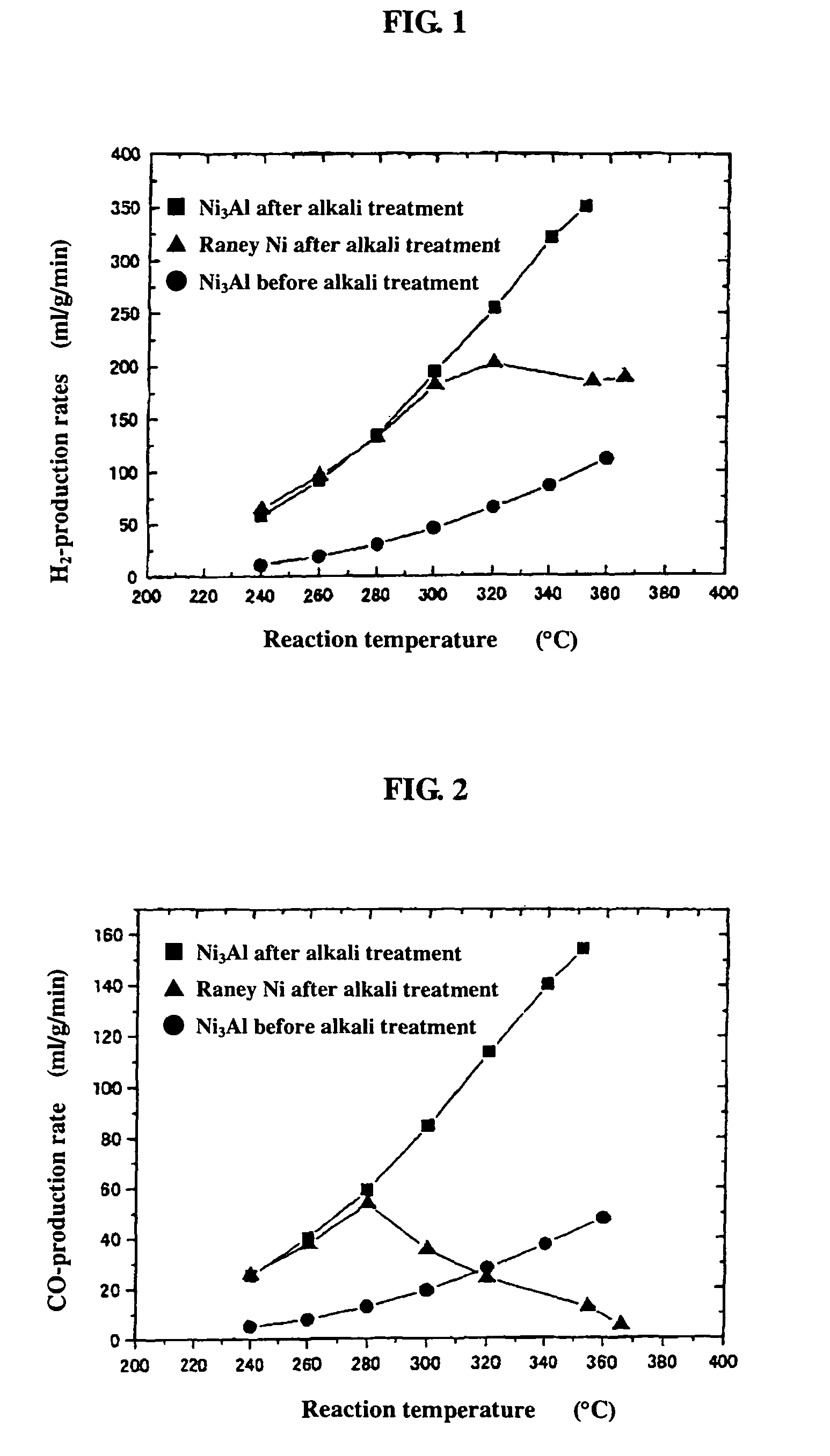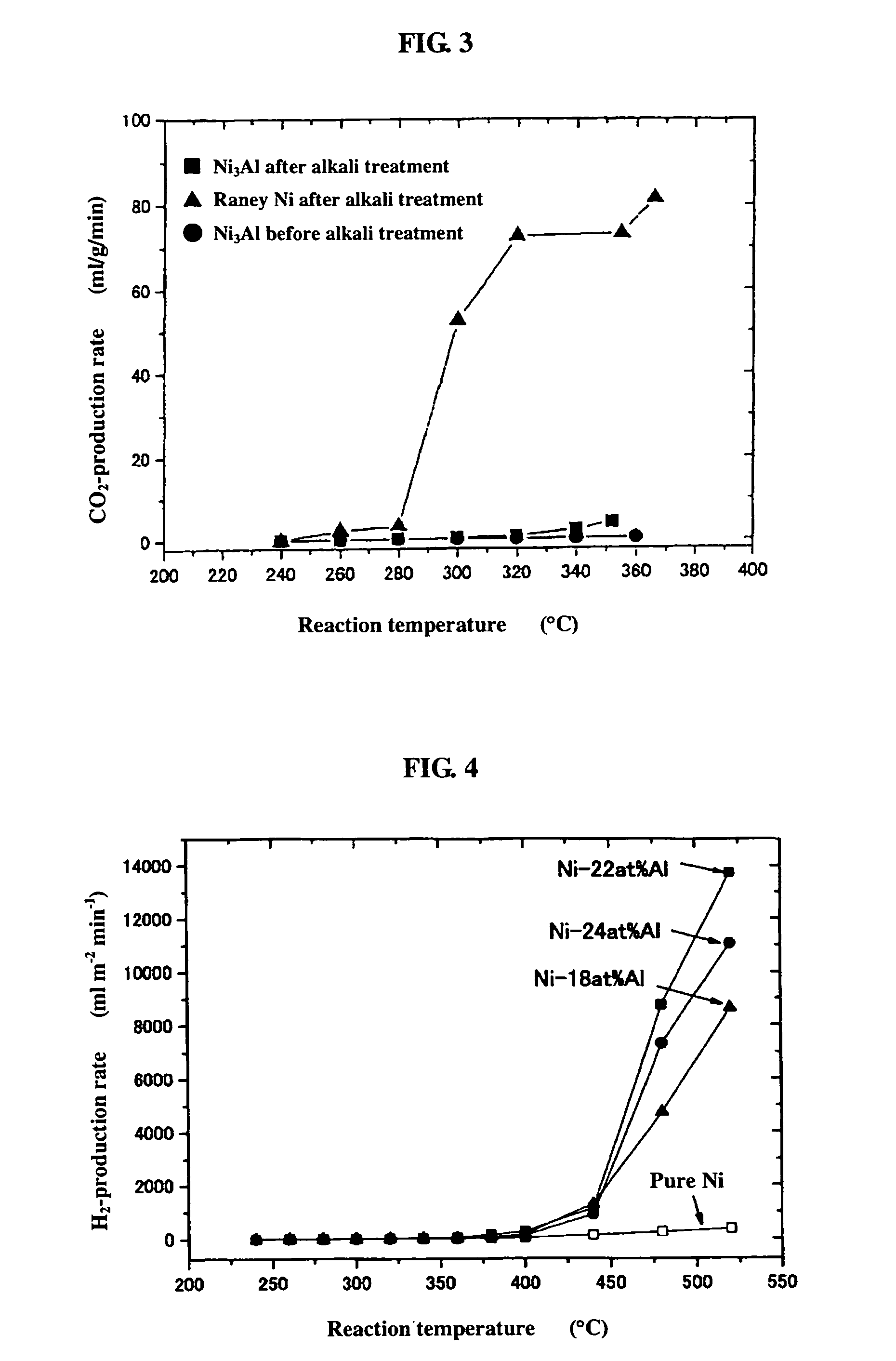Intermetallic compound Ni3Al catalyst for reforming methanol and methanol reforming method using same
a technology of methanol and catalyst, which is applied in the field of methanolreform catalyst, can solve the problems of low heat resistance of conventional catalysts and high cost of catalysts, and achieve the effects of high selectivity, high activity, and superior heat resistance and abrasion resistan
- Summary
- Abstract
- Description
- Claims
- Application Information
AI Technical Summary
Benefits of technology
Problems solved by technology
Method used
Image
Examples
example 1
[0042]The following two kinds of Ni3Al powder samples were prepared:
[0043](a) A Ni3Al powder sample having a composition of 86.91 wt % Ni and 13.09 wt % Al was prepared in a rotating disk atomization process. The specific surface area of the powder having a particle diameter of 32 μm or less as determined by the BET method was 1.3 m2 / g; the specific surface area of the powder having a particle diameter of 32 to 75 μm was 0.4 m3 / g; and the specific surface area of the powder having a particle diameter of 75 to 150 μm was 0.1 m2 / g.
[0044](b) A Ni3Al alloy ingot having a composition of 87.32 wt % Ni and 12.67 wt % Al was prepared in a melting furnace. Chips were produced from the ingot by machine work, and these chips were converted to a powder of 150 μm or less in diameter by mechanical polishing. Analysis by the BET method revealed that the specific surface area of the Ni3Al powder thus prepared was 2.3 m2 / g.
[0045]Then, the powder thus prepared was treated with the following alkali an...
example 2
[0053]0.2 g of the powder sample prepared by mechanical polishing in Example 1(b) above was subjected as catalyst to a hydrogen reduction treatment at 240° C. for 1 hour in a catalytic reactor [fixed bed-flow reactor], and the activity of the powder sample was evaluated under atmospheric pressure at reaction temperatures of 240° C., 260° C., 280° C., 300° C., 320° C., 340° C., and 360° C., by using a liquid mixture of methanol and water (CH3OH:H2O: 1:1.5 (mol)) as the raw material. The results are shown by black circular marks in FIGS. 1 to 3. As shown in FIG. 1, the hydrogen-production rate (ml / min / g) in the reaction increases as the temperature rises, but the rates are lower altogether. FIGS. 2 and 3 respectively show the CO- and CO2-production rates (ml / min / g) at each reaction temperature measured as a function of the reaction temperature. Apparently, the Ni3Al catalyst generated mainly CO, indicating that the Ni3Al catalyst was active in the methanol-decomposing reaction (CH3OH→...
example 3
[0054]0.2 g of the catalyst, i.e., the powder sample prepared by mechanical polishing in Example 1(b) above and treated with an aqueous 20% NaOH solution, was subjected to a hydrogen reduction treatment at 240° C. for 1 hour, and the activity of the powder sample was evaluated. The results are shown by black square marks in FIGS. 1 to 3. As apparent from FIG. 1, Ni3Al had a high hydrogen-production rate of 351 ml / min / g at 352° C. In addition, the alkali-treated Ni3Al catalyst had a superior high-temperature activity, showing a further increased hydrogen-production rate as the temperature rose. FIGS. 2 and 3 also show that mainly CO was formed. The results above indicate that the alkali treatment of Ni3Al leads to increase in catalytic activity.
PUM
| Property | Measurement | Unit |
|---|---|---|
| heat resistance | aaaaa | aaaaa |
| thickness | aaaaa | aaaaa |
| temperature | aaaaa | aaaaa |
Abstract
Description
Claims
Application Information
 Login to View More
Login to View More - R&D
- Intellectual Property
- Life Sciences
- Materials
- Tech Scout
- Unparalleled Data Quality
- Higher Quality Content
- 60% Fewer Hallucinations
Browse by: Latest US Patents, China's latest patents, Technical Efficacy Thesaurus, Application Domain, Technology Topic, Popular Technical Reports.
© 2025 PatSnap. All rights reserved.Legal|Privacy policy|Modern Slavery Act Transparency Statement|Sitemap|About US| Contact US: help@patsnap.com



